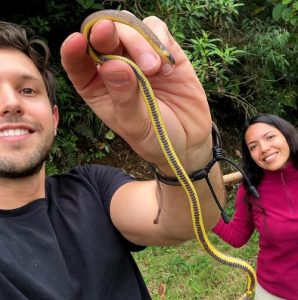Podcast: Play in new window | Download (Duration: 5:58 — 6.3MB)
Further reading:
Mysterious ‘blue goo’ at the bottom of the sea stumps scientists
Three new species of ground snakes discovered under graveyards and churches in Ecuador

Show transcript:
Welcome to Strange Animals Podcast. I’m your host, Kate Shaw.
I’ve come down a cold this week, and while I’m feeling better, it is settling into my chest as usual and I’m starting to cough. Since I’m still recovering and need to be in bed instead of sitting up researching animals, and since my voice is already sounding a little rough, here’s a Patreon episode this week instead of a regular episode. I had been planning to run old Patreon episodes for a few weeks in December so I could have some time off for the holidays, and those were already scheduled, so I just moved one of those episodes up to use this week instead.
This is a Patreon episode from October of 2022, where we talked about two very slightly spooky animal discoveries.
We’ll start with a suggestion from my brother Richard, about a strange newly discovered creature at the bottom of the ocean.
On August 30, 2022, the NOAA Ocean Exploration research team was off the coast of Puerto Rico. That’s in the Caribbean, part of the Atlantic Ocean. The expedition was mostly collecting data about the sea floor, including acoustic information and signs of climate change and habitat destruction. Since the Caribbean is an area of the ocean with high biodiversity but also high rates of fishing and trawling, the more we can learn about the animals and plants that live on the sea floor, the more we can do to help protect them.
When a remotely operated vehicle dives, it sends video to a team of scientists who can watch in real time and control where the rover goes. On this particular day, the rover descended to a little over 1,300 feet deep, or around 407 meters, when the sea floor came in view. Since this area is the site of an underwater ridge, the sea floor varies by a lot, and the rover swam along filming things and taking samples of the water and so forth, sometimes as deep as about 2,000 feet, or 611 meters.
The rover saw lots of interesting animals, including fish and corals of various types, even a fossilized coral reef. Then it filmed something the scientists had never seen before.
It was a little blue blob sitting on the sea floor. It wasn’t moving and it wasn’t very big. It was shaped roughly like a ball but with little points or pimples all over it and a wider base like a skirt where it met the ground. And it was definitely pale blue in color.
Then the rover saw more of the little blue blobs, quite a few of them in various places. The scientists think it may be a species of soft coral or possibly a type of sponge, possibly even a tunicate, which is also called a sea squirt. All these animals are invertebrates that don’t move, which matches what little we know about the blue blob.
The rover wasn’t able to take a sample from one of the blue blobs, so for now we don’t have anything to study except the video. But we know where the little blue blobs are, so researchers hope to visit them again soon and learn more about them.
Next, let’s return to dry land and learn about some newly discovered snakes. In fact, we’re not just on dry land, we’re way up high in the Andes Mountains in South America, specifically in some remote villages in Ecuador.
A teacher named Diego Piñán moved to the town of El Chaco in 2013, and he started noticing dead snakes on the road that he didn’t recognize. He also realized that people were killing the snakes on purpose. A lot of people are afraid of snakes, so Piñán made sure to teach his students about them so they would learn that most snakes aren’t dangerous. He also kept the dead snakes he found and preserved them in alcohol so he could figure out later what species they were. But he never could figure it out.
Then a scientist named Alejandro Arteaga assembled a team to study the animals found in remote areas of the Andes Mountains. When they came to Piñán’s town, they were excited to see the snakes he’d preserved, because even the snake experts on the team didn’t recognize the snakes either, although they were pretty certain they belonged to a genus of snakes called Atractus.
The snakes were quite pretty, gray-brown above with a bright yellow pattern underneath. They were small and slender, completely harmless to humans and pets, and they lived underground most of the time. The team searched and discovered more of the snakes living in the area. Most Atractus snakes are shy and stay away from people, but because the town of El Chaco had grown a lot recently, the snakes had moved from their home in the forest into the local cemetery. That’s right, they were burrowing around among the crypts. Of course, the snakes don’t know they’re in a graveyard. They just know they’re in a quiet place where people don’t visit very often to disturb them.
The team eventually found three new species of snake in different towns, all three described in September 2022. One species was living in the cemetery, another was in a schoolyard, and another was living near a church.
Still. Graveyard snakes.
Thanks for your support, and thanks for listening!